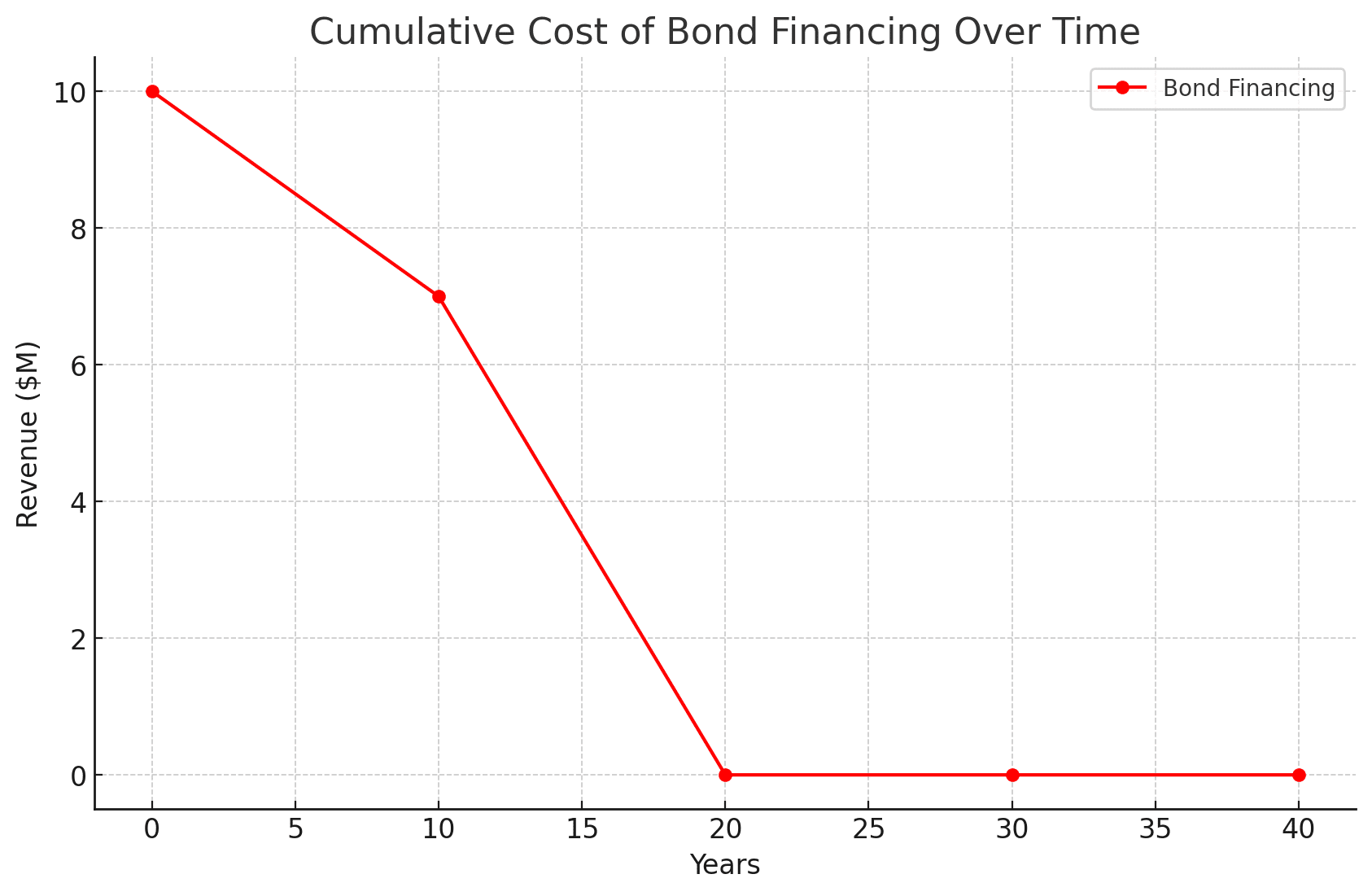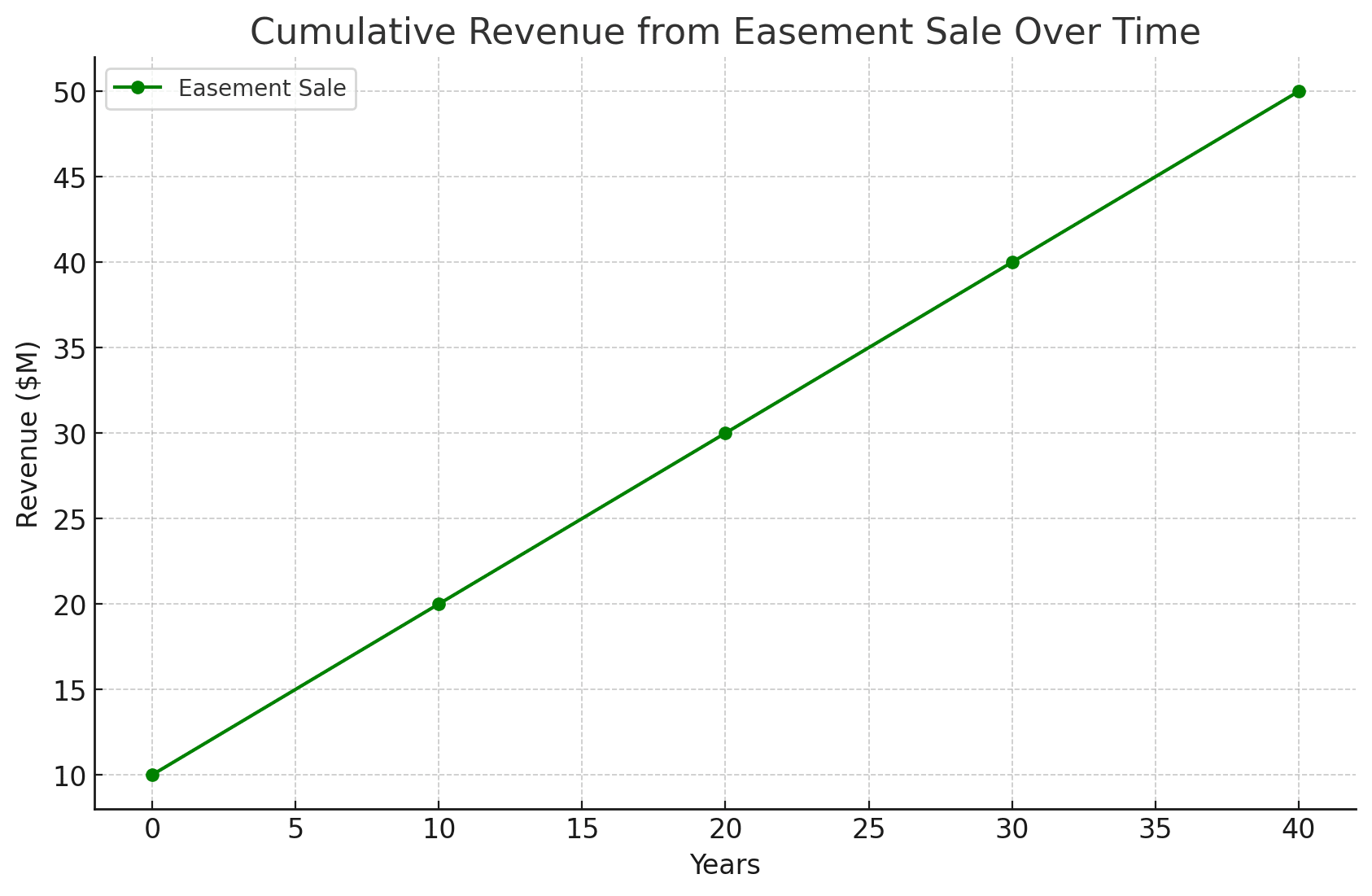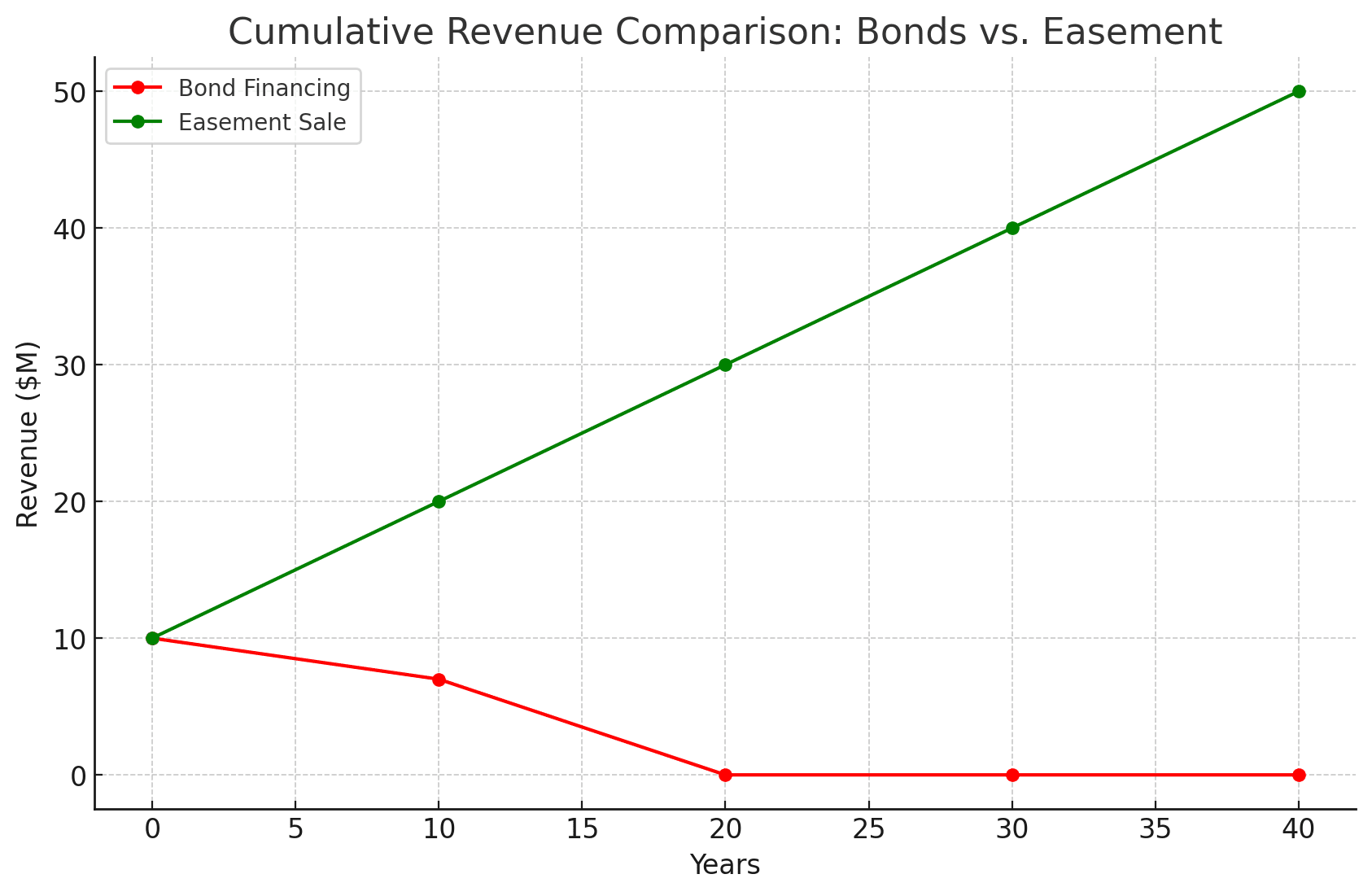As cities and municipalities seek to maximize revenue and secure financial stability amid growing financial pressures, they often face a critical decision: how best to leverage their assets to fund essential projects and services.
Traditionally, municipalities have relied on issuing bonds to raise capital. However, in an era where the landscape of telecommunications is rapidly evolving, there is a compelling case for cities to explore alternative financing methods. Instead of selling bonds, municipalities should consider partnering with cell tower infrastructure funds like Wireless Equity Group and cashing in on their cell tower and communications leases through a 40-55 year term easement or master lease.
This approach offers municipalities the immediate capital they need, while also unlocking the potential for increased revenue through strategic partnerships that enhance the value of their telecommunications infrastructure. This article will explore the advantages of selling through an easement compared to issuing bonds, the financial benefits of partnering with experts to optimize tower lease agreements, and why now is the ideal time for municipalities to consider this innovative strategy.
Contents
- 1 Understanding the Traditional Approach: Bond Financing
- 2 The Case for Selling Cell Tower Rights Through a 40-55 Year Term Easement
- 3 Comparing Financial Outcomes: Bonds vs. Easement
- 4 Leveraging Strategic Partnerships for Increased Revenue
- 5 Conclusion: A Forward-Thinking Approach to Municipal Finance
Understanding the Traditional Approach: Bond Financing

For decades, cities and municipalities have turned to bond financing as a tried-and-true method for funding public projects. Whether it’s building new schools, upgrading infrastructure, or expanding public utilities, municipal bonds have provided the financial backbone for many community developments. These bonds operate on a straightforward principle: a city or municipality borrows money from investors, with a promise to repay the principal amount along with interest over a predetermined period. The funds raised through these bonds allow local governments to embark on large-scale projects that might otherwise be financially out of reach.
How Bond Financing Works: When a city issues a municipal bond, it is essentially offering a form of debt to investors. These bonds are typically classified into two main types: General Obligation Bonds (GO Bonds) and Revenue Bonds. GO Bonds are backed by the full faith and credit of the issuing municipality, meaning they are supported by the city’s ability to levy taxes. Revenue Bonds, on the other hand, are repaid from the income generated by specific projects, such as toll roads or utilities.
Investors are attracted to municipal bonds for several reasons. First and foremost, the interest earned on these bonds is often exempt from federal income taxes, and sometimes state and local taxes as well, making them an attractive option for risk-averse investors looking for stable, tax-advantaged returns. Moreover, because these bonds are backed by government entities with taxing power or revenue-generating projects, they are generally seen as low-risk investments.
Advantages of Bond Financing:
- Immediate Capital: One of the most significant advantages of bond financing is the ability to raise large sums of money quickly. When a bond issue is successful, it can generate the capital needed to kickstart vital projects without delay. This immediacy is crucial for addressing urgent community needs, such as repairing aging infrastructure or constructing new public facilities.
- Low-Risk Perception: Municipal bonds are often viewed as safe investments, especially compared to corporate bonds or equities. The backing by a municipality’s taxing authority or a reliable revenue stream gives investors confidence that they will receive their interest payments and eventually their principal. This perceived safety allows cities to borrow at relatively low interest rates, reducing the overall cost of financing.
- Public Support: Bonds are a familiar financial instrument, both to municipal governments and the public. Because of their long history and generally positive outcomes, bond measures often garner voter approval when put to a public vote. This support is bolstered by the fact that bond proceeds are typically earmarked for specific, tangible improvements that directly benefit the community, such as schools, parks, or transportation projects.
While bond financing offers several advantages, it also comes with significant drawbacks that cities must carefully consider.
The Drawbacks of Bond Financing:
While bonds have been a cornerstone of municipal finance, they are not without significant challenges. The reliance on bonds to fund public projects introduces several complexities that can constrain a city’s financial flexibility and impose long-term burdens.
- Long-Term Debt Obligation: Municipal bonds create a long-term debt obligation that must be managed carefully. The city is committed to making regular interest payments over the life of the bond, which can span 20, 30, or even 40 years. This ongoing financial commitment can strain the city’s budget, particularly during economic downturns when tax revenues may decline. Furthermore, the principal repayment at the bond’s maturity can be a significant financial outlay, often requiring careful planning and potentially limiting the city’s ability to take on new projects or initiatives.
- Interest Costs: Although municipal bonds typically offer lower interest rates than other forms of borrowing, the interest costs over the life of the bond can still be substantial. For example, a $100 million bond issued at an interest rate of 3.5% over 30 years could result in the city paying over $50 million in interest alone. This added expense must be weighed against the benefits of the financed project, particularly when considering the total cost of borrowing over such an extended period.
- Inflexibility: Bonds are a relatively inflexible financing option. Once issued, the terms of the bond—including the interest rate and repayment schedule—are fixed. If a city’s financial situation changes, it has limited options for adjusting these terms without potentially incurring penalties or damaging its credit rating. This inflexibility can be a significant drawback in a dynamic economic environment where the needs and priorities of a municipality might evolve over time.
- Pressure to Manage Public Funds: The responsibility of managing public funds effectively while servicing bond debt can be a significant pressure on city officials. Mismanagement or unforeseen economic challenges can lead to budget shortfalls, forcing the city to cut services or raise taxes to meet its obligations. This pressure is particularly acute in situations where the projects funded by the bonds do not generate the expected economic benefits, leaving the city with debt that does not correspond to a tangible increase in revenue or public good.
- Voter Approval and Political Challenges: While bonds can gain public support, they are not always a guaranteed win at the ballot box. Proposing a bond issue often requires a referendum or public vote, and securing approval can be a politically challenging process. Taxpayers might be wary of increasing public debt, particularly if they do not see an immediate benefit from the proposed projects. The need for voter approval adds an additional layer of complexity and uncertainty to the bond issuance process.
While bond financing remains a popular and reliable method for funding public projects, it is not without significant drawbacks that cities must carefully consider. The long-term debt obligations, interest costs, and inflexibility associated with bonds can constrain a city’s financial flexibility and impose burdens that extend far beyond the immediate benefits of the projects they fund. As cities face evolving economic conditions and the need for more adaptive financial strategies, exploring alternative methods—such as selling cell tower rights through long-term easements—may offer a more effective way to leverage municipal assets and secure financial stability without the pitfalls of traditional bond financing.
The Case for Selling Cell Tower Rights Through a 40-55 Year Term Easement

As cities and municipalities navigate the complexities of funding critical public projects, they increasingly seek alternatives to traditional methods like bond financing. Selling cell tower rights through a long-term easement or master lease presents a compelling, forward-thinking strategy that addresses many of the limitations associated with bonds. This innovative approach involves leasing the rights to a cell tower for an extended period, typically between 40 and 55 years, in exchange for an upfront lump sum payment. At the conclusion of the easement term, the rights revert to the city, potentially opening up new avenues for revenue generation in the future.
How a Long-Term Easement Works
In this arrangement, a city enters into an agreement with a communications infrastructure firm, like Wireless Equity Group, which specializes in cell tower assets. The city grants the Wireless Equity Group the right to operate and manage the cell tower on municipal property for the duration of the easement (or Master Lease). In return, the city receives a significant lump sum payment upfront, which can be used immediately to fund public projects, pay down debt, or bolster city reserves.
Unlike a perpetual sale where the city permanently relinquishes its rights to the property, a long-term easement allows the city to maintain a degree of control over its assets. Once the easement period ends, the city can reassess the value of the property, renegotiate terms, or explore new leasing opportunities. This reversionary interest provides flexibility that a straightforward sale does not offer.
Advantages of Selling Through an Easement
- Immediate, Significant Capital: Just like bond financing, selling a long-term easement provides immediate capital that the city can deploy to meet pressing financial needs. However, the lump sum payment received from the easement can often be more substantial and immediate than what bonds might yield after factoring in interest payments and other associated costs. This is because easements eliminate the need for the city to service debt over many years, allowing for a cleaner and more direct financial transaction.
- Example Scenario: Suppose a city is offered $20 million for a 50-year easement on several cell tower sites. This lump sum can be allocated to critical infrastructure projects, social services, or other civic initiatives without the need to repay the amount over time, as would be required with bond financing.
- No Long-Term Debt Obligation: One of the most significant advantages of selling through an easement is that it does not create long-term debt obligations for the city. Unlike bonds, which require the city to make regular interest payments and eventually repay the principal, an easement transaction is a one-time payment. This means that the city does not have to worry about future financial liabilities, freeing up resources that would otherwise be tied to debt service. This financial freedom allows the city to maintain a healthier balance sheet, reduce the risk of budgetary constraints during economic downturns, and avoid the potential credit rating downgrades that can occur with high levels of debt. By not adding to its debt load, the city also preserves its borrowing capacity for future needs.
- Revenue Enhancement Through Strategic Partnerships: A long-term easement opens the door for strategic partnerships with firms, like Wireless Equity Group, that specialize in maximizing the value of communications assets. Our team brings expertise in negotiating and optimizing cell tower leases, which can significantly increase the revenue generated from these assets over the easement term. Additionally, Wireless Equity Group would leverage our expansive network to bring on new carriers and additional revenue streams to the site.
- Key Revenue Enhancement Strategies:
- Adding More Tenants: Cell towers often have the capacity to host multiple tenants (such as different wireless carriers), and a professional management partner can help maximize this potential by adding more tenants to existing towers. Each additional tenant increases the revenue generated by the site, providing a steady income stream throughout the easement period.
- Renegotiating Existing Leases: Many existing cell tower leases are based on outdated market rates. Wireless Equity Group has data on over 23,000 leases across the country and can negotiate agreements mutually beneficial to all parties. A strategic partner, like Wireless Equity Group, can renegotiate these leases to secure higher rents, better escalators, and more favorable terms for the city. This ensures that the city is receiving the maximum possible value from its telecommunications assets.
- Ensuring Long-Term Protection: The telecommunications landscape is constantly evolving, with new technologies and regulations emerging regularly. A specialized partner can help the city navigate these changes, ensuring that its interests are protected and that the terms of the easement are structured to adapt to future developments.
Case Study: Consider a scenario where a city partners with a firm like Wireless Equity Group to manage its cell tower leases. Initially, the city was earning $750,000 annually from its towers. After strategic tenant additions and lease renegotiations, the annual revenue increases to $1.5 million. Over a 40-year easement term, this enhanced revenue results in an additional $30 million in income, on top of the upfront payment received at the outset of the easement.
Long-Term Flexibility and Future Opportunities
One of the most compelling aspects of selling through a long-term easement is the flexibility it offers at the end of the term. Unlike a permanent sale, where the city loses control of its assets indefinitely, an easement allows the city to regain its rights after 40-55 years. This reversionary interest provides the city with future opportunities to renegotiate the terms of the lease, explore new technological developments, or even repurpose the site for other municipal needs.
This flexibility is particularly valuable in the rapidly changing telecommunications industry, where new technologies and market dynamics can significantly alter the value and utility of cell tower sites. By maintaining ownership rights after the easement period, the city ensures that it remains in a position to capitalize on these changes.
Risk Mitigation and Predictable Revenue
Selling through a long-term easement also helps mitigate several risks associated with traditional bond financing. With bonds, the city is exposed to interest rate fluctuations, economic downturns, and the potential for lower-than-expected tax revenues, all of which can complicate debt repayment. In contrast, an easement provides a predictable revenue stream without the uncertainties of fluctuating interest rates or the need to meet future debt obligations.
Moreover, by securing an upfront payment, the city can immediately address its financial needs, reducing the risk of project delays or cost overruns that often plague bond-financed initiatives. This predictability and immediate capital infusion make easements an attractive alternative for municipalities seeking to stabilize their finances and invest in long-term growth.
A Strategic Alternative to Bond Financing
Selling cell tower rights through a 40-55 year term easement offers a strategic alternative to bond financing that can provide cities with immediate capital, enhanced revenue opportunities, and long-term flexibility without the burden of debt. By partnering with experienced telecommunications asset managers, cities can maximize the value of their assets and secure a stable financial future.
As municipalities face increasing demands on their budgets and the need for innovative financing solutions, the case for selling through an easement becomes even more compelling. This approach not only addresses many of the limitations of traditional bond financing but also positions cities to take full advantage of the evolving telecommunications landscape, ensuring sustained revenue and financial stability for years to come.
Comparing Financial Outcomes: Bonds vs. Easement
When cities and municipalities consider how to fund significant projects or manage their assets, understanding the financial implications of different approaches is critical. This section compares the financial outcomes of two common strategies: issuing municipal bonds versus selling cell tower rights through a long-term easement. By examining these options in detail, it becomes clear how each can impact a city’s financial health and long-term revenue potential.
Bond Issuance Example
Let’s start by examining a typical bond issuance scenario:
- Amount Raised: $10 million
- Interest Rate: 3.5%
- Term: 20 years
- Total Repayment: $14.1 million
In this scenario, the city raises $10 million immediately, which can be used to fund projects or cover budgetary needs. However, this upfront capital comes at a cost. Over the 20-year term of the bond, the city is obligated to make interest payments totaling $4.1 million, bringing the total repayment to $14.1 million. This creates a substantial long-term financial commitment, reducing the city’s financial flexibility and increasing its debt burden.
Graph 1: Cumulative Cost of Bond Financing Over Time
This graph illustrates the cumulative cost of servicing the bond over 20 years. It shows how the initial $10 million raised gradually diminishes as interest payments accumulate, ultimately resulting in a total repayment of $14.1 million.

Easement Sale Example
Now, let’s consider the alternative: selling cell tower rights through a long-term easement.
- Lump Sum Payment: $10 million
- Additional Revenue from Lease Optimization: $1 million per year (from adding tenants and renegotiating leases)
- Total Revenue Over 40 Years: $50 million
In this scenario, the city receives the same $10 million upfront as it would with bond financing. However, unlike bonds, there is no repayment obligation. This means the city does not have to allocate future resources to servicing debt. Additionally, by partnering with an experienced telecommunications firm to optimize the cell tower leases, the city can generate an additional $1 million per year in revenue. Over the 40-year easement period, this amounts to an extra $40 million, resulting in a total revenue of $50 million.
Graph 2: Cumulative Revenue from Easement Sale Over Time
This graph shows the cumulative revenue generated from the easement sale, including the additional annual income from lease optimizations. The graph demonstrates how the revenue grows over time, significantly outpacing the bond financing scenario.

Comparative Analysis: Bonds vs. Easement
To provide a clear comparison between these two approaches, it’s helpful to look at how the financial outcomes stack up over time. Below is a table summarizing the cumulative financial impact of each approach over a 40-year period.
Table 1: Cumulative Financial Impact Comparison
| Year | Bond Financing ($M) | Easement Sale ($M) |
|---|---|---|
| 0 | 10 | 10 |
| 10 | 7 | 20 |
| 20 | 0 | 30 |
| 30 | 0 | 40 |
| 40 | 0 | 50 |
In this comparison:
- Year 0: Both strategies provide an immediate $10 million in capital.
- Year 10: The bond financing option has cost the city $3 million in interest payments, reducing the net capital benefit to $7 million, while the easement sale has already generated an additional $10 million in revenue from lease optimization, bringing the total to $20 million.
- Year 20: The bond is fully repaid, and the city has no further debt but also no additional revenue from the bond. In contrast, the easement continues to generate revenue, with the total reaching $30 million.
- Year 30: The easement continues to produce revenue, totaling $40 million.
- Year 40: The easement sale results in a cumulative revenue of $50 million, significantly outpacing the net benefit of bond financing.
Graph 3: Cumulative Revenue Comparison: Bonds vs. Easement
This comparative graph highlights the difference in financial outcomes between the two approaches. It clearly shows that while bond financing results in a diminishing financial benefit due to interest payments, the easement sale continues to generate increasing revenue, ultimately providing a far greater financial benefit to the city.

Financial Superiority of Easement Sales
The comparison between bond financing and selling cell tower rights through a long-term easement demonstrates the clear financial superiority of the easement approach. While bond financing offers necessary capital, it comes with significant long-term costs and constraints. In contrast, an easement sale not only delivers immediate capital without the burden of debt but also unlocks ongoing revenue opportunities through lease optimizations. Over a 40-year period, the financial outcomes of an easement sale significantly surpass those of bond financing, making it the superior choice for municipalities aiming to maximize revenue and secure long-term financial stability.
Ultimately, the financial analysis clearly shows that selling cell tower rights through a long-term easement not only provides greater immediate capital but also secures a far more favorable long-term revenue stream, making it a superior option for municipalities.
Leveraging Strategic Partnerships for Increased Revenue
One of the most significant advantages of selling cell tower rights through a long-term easement is the opportunity to form strategic partnerships with telecommunications asset management firms, like Wireless Equity Group. We specialize in negotiating and managing cell tower leases, bringing a level of expertise that cities may not have in-house. By partnering with Wireless Equity Group, cities can maximize the value of their communications assets, unlocking additional revenue streams and optimizing existing agreements.
Key Benefits of Partnering with Experts
- Increased Tenant Revenue: Wireless Equity Group is adept at identifying and capitalizing on opportunities to increase the number of tenants on a single cell tower. Many towers have the capacity to host multiple tenants, such as different wireless carriers, government agencies, or emergency services. Each additional tenant on a tower represents a new revenue stream. Wireless Equity Group can effectively market the available space to potential tenants, negotiate favorable lease terms, and ensure that the tower operates at full capacity. By increasing tenant density, cities can significantly boost the annual revenue generated from their towers, transforming underutilized assets into high-performing income sources.
- Optimized Lease Agreements: Existing cell tower leases may not reflect the current market value of the property or the best possible terms for the city. Wireless Equity Group brings the expertise needed to renegotiate these leases. We can secure higher rents, implement escalator clauses that increase rent payments over time, and negotiate more favorable renewal terms that benefit the city in the long run. These optimizations not only increase immediate revenue but also ensure that the city continues to benefit from its assets as market conditions evolve.
- Risk Mitigation: The telecommunications industry is dynamic, with frequent technological advancements and shifts in market demand. This volatility can pose risks to cities that manage their cell tower leases independently. Strategic partners help mitigate these risks by continuously monitoring market trends, assessing the financial health of tenants, and anticipating changes in technology that could impact the value of the tower. For example, the transition from 4G to 5G networks has created both challenges and opportunities for cell tower owners. A knowledgeable partner can navigate these changes, ensuring that the city’s assets remain valuable and competitive in the evolving market.
Case Study: Revenue Growth Through Expert Partnership
To illustrate the tangible benefits of strategic partnerships, consider the following case study of a city that successfully optimized its cell tower leases by collaborating with a telecommunications asset management firm.
Initial Scenario:
- Before the partnership, the city earned $500,000 annually from its cell tower leases. These leases were based on older agreements with minimal escalations and a limited number of tenants.
Post-Partnership Outcomes:
- After partnering with the firm, the city undertook a comprehensive review and renegotiation of its existing leases. The firm successfully added new tenants to several towers, negotiated higher rent rates, and introduced more favorable terms.
- As a result, the city’s annual revenue from these leases increased to $1.5 million—a 300% improvement.
Graph 2: Revenue Growth Before and After Partnership
| Year | Before Partnership ($M) | After Partnership ($M) |
|---|---|---|
| 1 | 0.5 | 1.5 |
| 5 | 2.5 | 7.5 |
| 10 | 5.0 | 15.0 |
| 20 | 10.0 | 30.0 |
| 40 | 20.0 | 60.0 |
This significant increase in revenue provided the city with additional resources that could be allocated to public projects and services, improving overall community welfare. The partnership not only boosted immediate income but also positioned the city to continue benefiting from its telecommunications assets for decades to come.
The Long-Term Strategic Benefits
Beyond the immediate financial gains, selling cell tower rights through a 40-55 year term easement and forming strategic partnerships offer cities several long-term strategic advantages:
- Preservation of Future Opportunities: A major benefit of a term easement, as opposed to an outright sale, is that the city retains future rights to the asset. At the end of the easement term, the city regains control of the tower rights. This means that in 40-55 years, the city can renegotiate the terms based on the prevailing market conditions or explore new revenue streams as technology continues to evolve. The potential for future earnings is preserved, providing the city with a valuable asset that can be re-leveraged in the future.
- Flexibility in Asset Management: Without the burden of debt repayment that typically accompanies bond financing, cities have greater flexibility in managing their financial resources. The upfront capital received from the easement can be used to fund immediate needs, while the ongoing revenue from lease optimizations can be reinvested in other areas. This flexibility allows cities to respond more effectively to changing economic conditions, allocate funds where they are most needed, and pursue long-term growth strategies without the constraints of debt.
- Alignment with Modern Telecommunications Trends: The telecommunications industry is characterized by rapid technological advancements, such as the rollout of 5G networks and the increasing demand for data services. Cities that have strategic partnerships in place are better positioned to adapt to these changes. A knowledgeable partner ensures that the city’s telecommunications assets are aligned with current and future trends, optimizing revenue streams and maintaining the relevance of the assets in an ever-changing market.
Maximizing Value Through Strategic Partnerships
Selling cell tower rights through a long-term easement, coupled with the expertise of a telecommunications asset management firm, offers cities a powerful way to maximize the value of their assets. By increasing tenant density, optimizing lease agreements, and mitigating risks, cities can significantly boost their revenue and secure a stable financial future. Additionally, the long-term flexibility and alignment with modern telecommunications trends ensure that cities are well-positioned to continue benefiting from their assets for years to come. This strategy not only provides immediate financial benefits but also preserves the city’s ability to capitalize on future opportunities in a rapidly evolving industry.

Conclusion: A Forward-Thinking Approach to Municipal Finance
In an era where cities face growing demands for infrastructure, services, and financial stability, it is crucial to explore innovative financing strategies that maximize value while minimizing risk. Selling cell tower rights through a 40-55 year term easement offers municipalities a compelling alternative to traditional bond financing. This approach not only provides immediate capital without the burden of long-term debt but also unlocks significant potential for ongoing revenue through strategic partnerships. The flexibility inherent in the easement model allows cities to adapt to future changes, renegotiate terms, and capitalize on new opportunities as they arise.
By rethinking how they manage their telecommunications assets, cities can secure a stronger financial future, generate more revenue for public services, and maintain the flexibility needed to navigate the challenges of the 21st century. This forward-thinking approach ensures that municipalities are not only addressing their immediate financial needs but also preparing for long-term success, positioning themselves to thrive in an ever-evolving economic landscape.
As municipalities look to the future, now is the time to explore the strategic benefits of long-term easements. By partnering with Wireless Equity Group, cities can unlock new opportunities for financial growth and stability.




